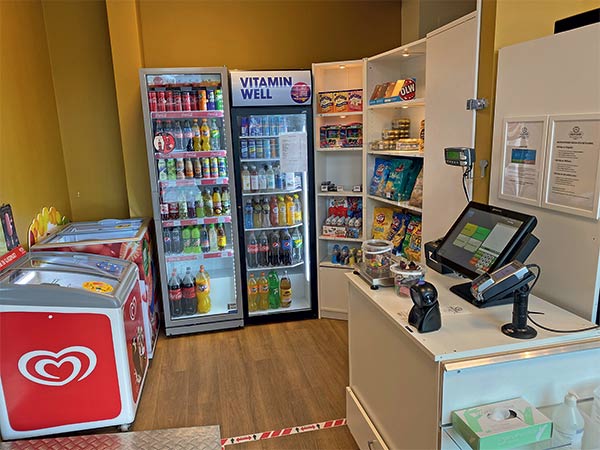
Carl Stael von Holstein emphasise that the emergence of more advanced access control solutions is enabling the shift to cashierless, or hybrid stores, as they allow to manage operations remotely. As an example, he mentions that stores can opt for advanced scheduled door access, where access is granted within a set timeframe. Outside of these scheduled hours, any attempted access is subject to additional security measures and requires authentications.
“To further enhance these measures, stores can restrict access by ensuring doors are only unlocked once approved personnel, such as a security worker, has been granted access by a specific PIN code, card number or access rule. This ‘first person in’ system is well suited to hybrid stores”, adds Carl Stael von Holstein, as he is interviewed on the topic access control in retail.
So how to secure seamless authentication for cashierless stores?
“Through installing network intercoms at the store entrance and exit to recognise use dynamic or static QR-codes, which can be used by the customer to allow them access to the store.”
What more can the technology do for the customer?
“Once inside, a targeted marketing message can then be played over the IP audio, such as ceiling or cabinet speakers, to further enhance the store experience, alongside a welcoming message on in-store monitors. After purchasing their goods at the self-checkout, a QR code on the customer’s receipt or mobile phone would enable them to leave by simply allowing it to be scanned by an integrated camera at the service terminal.”

Can you give examples of what difference a security system – where video and access control work seamlessly together – can make if an incident occurs?
“One example is if a customer finds themselves unable to enter the store, the operation centre can be notified in real-time, verify the customer and open the door remotely to grant them access.”
“Another example is that it enables to search where an IDholder has been denied entry, and not only would you receive a log, but also video material showing the event with a synchronised time stamp. This information removes the need to search and collate different materials from two separate databases to create an account of the incident. This not only saves time and resources, but also demonstrates how store entry can be managed securely while being remotely operated.”
Integrated with edge-based analytics, what can access control do more than simply letting customers through the door?
“When network intercoms, cameras and sensors start communicating, and smart analytics are applied, this technology can be developed to go beyond the basic functionality of analogue and proprietary systems.”
Can you give examples?
“Intelligent IP-based access control enables the centralised management of all entry points – whether in the store itself, or in stock rooms and administrative areas. These solutions are already being used in retail delivery areas where vehicles are constantly dropping off or collecting goods, to ensure operations run smoothly.”
Can you explain how it works?
”Typically, the delivery company registers their vehicle before arriving, and during regular working hours a gate will open once the license plate recognition application in the camera identifies the delivery truck.
And what about the procedure after working hours?
”During the night an extra layer of security can be added: as soon as the camera recognises the truck an alert is triggered to the security centre. An operator then opens the gate remotely after visual verification.”
With the retail industry looking for more innovative solutions to manage operations and ease staff pressure, how can these capabilities be readily replicated in-store?
“For instance, you can now add virtually any type of credential to operate a door or a function. From more traditional access identity types such as key fobs and PIN codes to static and dynamic QR codes or license plate recognition for vehicle access, the flexible multi factor authentication methods that are now available within network door controllers present a highly secure and flexible offering.”
Access control can also streamline staff movement around your store through automated processes. Can you give an example?
“For instance, the use of QR codes on badges enables internal doors to be automatically opened between the main store and stockrooms. This touchless solution means that staff can move throughout the premises with minimal friction, which is particularly beneficial if they are carrying and transferring boxes of stock from one part of the store to another. This not only eases processes for your staff, but also saves valuable time, with the potential to save several hours per week.”
“Plus, with multi-site capabilities, these solutions can be used to monitor multiple stores in one system and across the same network, thereby easing processes.”
Security certainly remains a top priority for retail, particularly during periods of high footfall in peak shopping times. How can technology ensure a high level of security, while helping the staff to deliver a positive service and experience for their customers?
“The use of physical security devices may appear an obvious solution, with cameras having long been used in retail to deter criminal activity and ensure the safety of staff and customers. However, combining access control solutions with other security solutions like network intercoms, cameras and sensors allows for interoperability between devices. This can bolster retail security significantly, particularly within digitally-enabled stores that have less staff present.”
How can that be fulfilled?
“Integrating technology with an intelligent, powerful and easy-to-use action rule engine enables you to set up rules and triggers that can elevate in-store security.”
Can you give examples of actions and what can come out of that?
“By adding a people counter to an existing camera at the entrance, you can control access so that only one customer can enter the store at a time. This real-time detection restricts access, triggering an alarm if it is more than one customer. With the combined use of network audio, you can inform customers of this via a predefined message or address them directly via a connected service centre.
Any other good example, where access control is the main factor as part of the integrated solution?
“In luxury retail, integrated solutions can be used to protect drawers or cabinets with high value merchandise. Once the drawer is opened by a staff member, an alert is shared with employees over the speaker in the staff room. Images from a camera directed towards the drawers can be automatically displayed on the monitor in the back office, allowing staff to remotely monitor activity. Plus, with advanced access control solutions in place, doors can be automatically locked if an incident were to occur.
Can you mention a specific access control application that can contribute to the security in stores with valuable goods?
“You can create a ‘vestibule’ with two sets of interlocking doors. This can be a particularly secure way to protect luxury goods, as it requires the first set of doors to close before the second set can open. With an integrated network video intercom, which uses two-way communication and video identification, you can operate remote entry control. This reduces the need for additional security personnel and improves security measures. This interoperability is of course not limited to luxury retail, any store with valuable goods can integrate combined solutions to bolster security and minimize risk of theft.
Being able to quickly increase the size or number of your stores provides a competitive advantage. How can security solutions keep pace?
“With edge-based access control, scalability and futureproofing are ensured whether there are one or a thousand doors in the system and multi-site capabilities enable centralised control across any number of stores.”
“Plus, this openness means adding new network intercoms, other devices or new functionalities is easy, should your business needs change over time. Intelligence on the edge also ensures solutions avoid complicated and time-consuming wiring to a central server, which simplifies any required changes as you look to scale.”
Why is platforms based on open standards so important for a scalable future proof solution?
“With open platforms integrations from third-party suppliers can interact to provide solutions which are significantly more than the sum of their parts. These platforms are a giant leap towards making retail stores truly smart places, and provide solid foundations for you to build on.
















